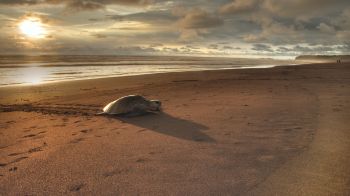Turtles have always been important in ethnic religions and mythology, as a symbol of thoughtfulness and perseverance they were valued in many cultures and worshiped as deities or beings with supernatural powers.
Unfortunately sea turtles are still being treated as a delicacy and inexplicably their shells are traded to produce macabre decorative tortoiseshell objects. Even the nests of these now endangered animals are not spared, the eggs are stolen by so called "collectors" and sold as aphrodisiacs or as a specialty.
Sea turtles belong to the reptiles and its present appearance has remained almost unchanged for some 150 million years. They spend the majority their life at the sea, only coming ashore to lay their eggs in the sand.
There are five species of sea turtles native to Costa Rica: The Green Sea Turtle the Hawksbill Sea Turtle, the Olive Ridley Sea Turtle, the Leatherback Sea Turtle and the Loggerhead Sea Turtle. In no place in the world you can better observe turtles than here in Costa Rica, where the females come ashore on beaches of the Pacific and Atlantic coasts to dig there their nests in the soft sand. When you are at the right place at the right time you can witness this unique spectacle.
The 35-kilometer-long Tortuguero beach is the most important nesting site for the Caribbean Green Sea Turtle, whose mating behaviour is well studied. After mating, usually from September to November, the females wait off the coast until nightfall, then she will leave the safety of the sea and embark on the arduous journey across the beach to the appropriate nesting ground.
Even the un-hatched turtles have plenty of enemies like the White-Nosed Coati, Dogs, Crab-Eating Raccoons, Human Egg Dealers and other similar predators. When the eggs have survived undamaged for two months the baby turtles hatch and now have to reach the sea before being eaten by crabs and birds. They wait until dusk, orienteering themselves towards the brightest spot on the horizon, and then in the supposedly safe waters many of them fall prey to sharks and other predatory fish.
To give the turtles the opportunity to nest in peace and especially to give the youngsters the chance to safely reach the ocean, there are beaches in the National Parks that are actively involved such as the Tortuguero National Park.
Every night you have the opportunity to observe Olive Ridley turtles. Only about three percent of the young survive. They feed, close to the coast on turtle grass and can travel long distances in the open ocean. After 50 years they are sexually mature and return to the beaches where they hatched to mate.
Every year, countless turtles are caught in fishing nets or are even officially approved as catch, although they are still at risk of extinction.
Their survival depends, most certainly, on the responsibility of tourists when they are offered turtle products and from the ever-growing understanding of our ecological relationships.
The future of these lovable creatures is in our hands.

We would like to thank all our guests who have been travelling with us since 1994 in the most beautiful time of the year - their well-deserved holidays. When developing itineraries for groups and individual travelers, selecting our local service partners and caring about the well-being of our guests, we always focus on the highest possible quality standards. Since the founding of Amadeus Travel, we have been committed to sustainable tourism as the only long-term viable form of tourism, e.g. through our social commitment, visiting and supporting private and state nature reserves as well as the training of our team and experienced, fully licenced tour guides.











 Book Now
Book Now 


